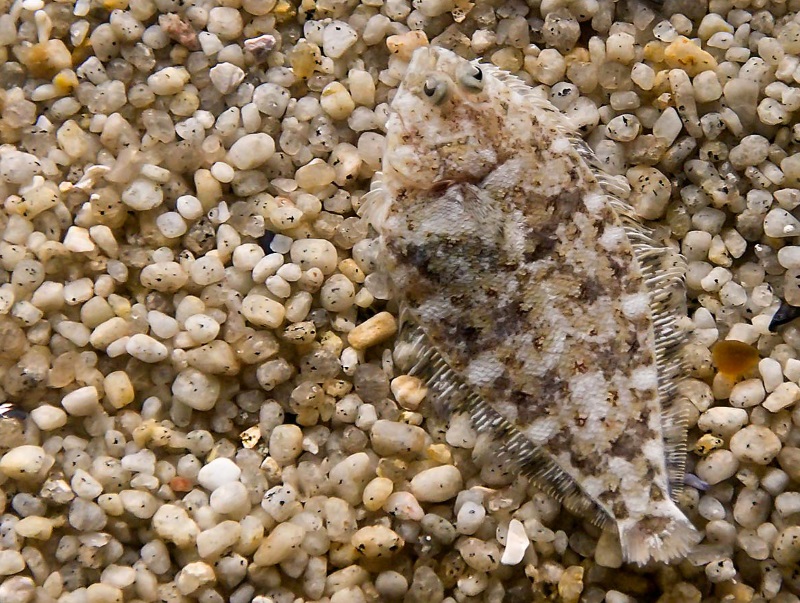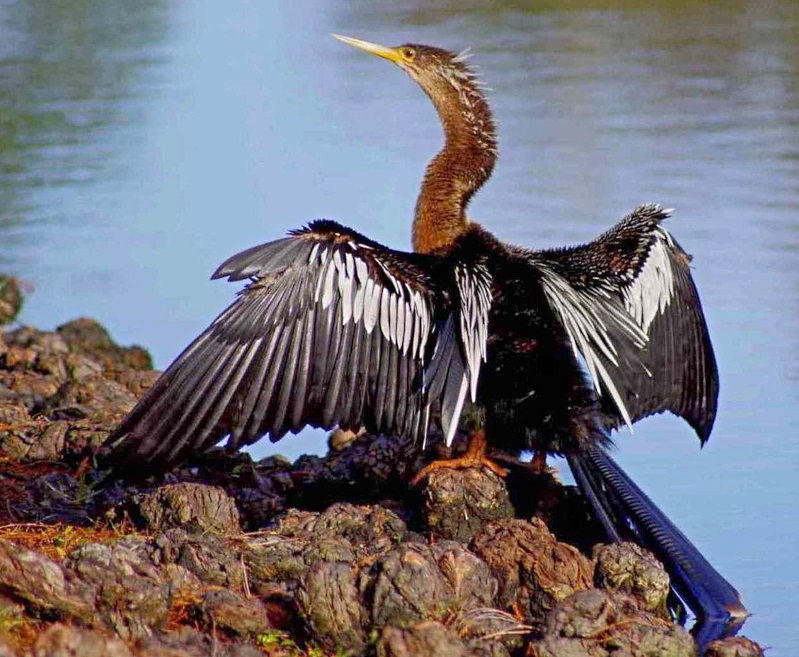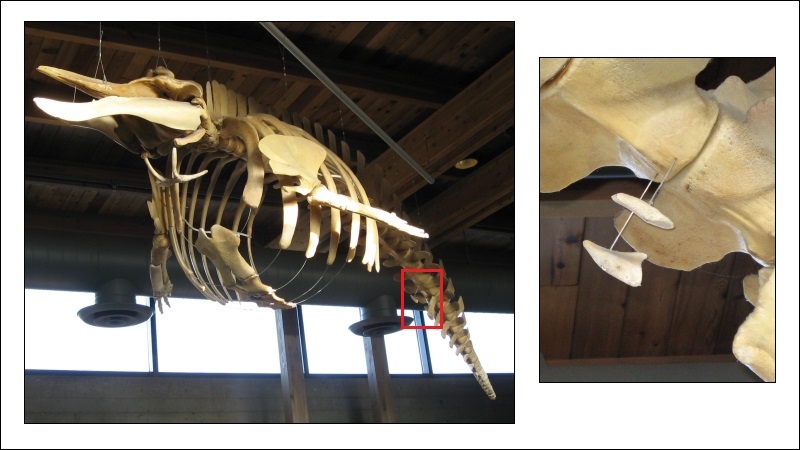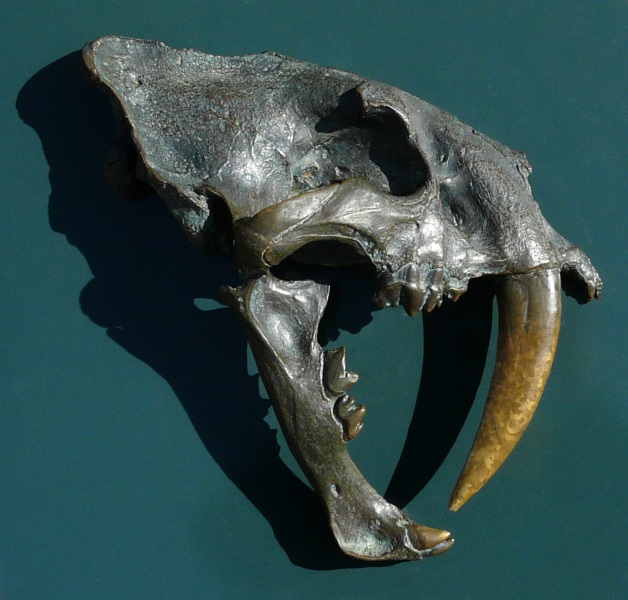
* Notions such as the tree of life and the geographic distribution of species were powerful arguments in Darwin's case for evolution. He also pointed out that the adaptation of organisms demonstrate an improvised approach consistent with his theory, and noted how nature seemed to keep "reinventing" the same forms for different animals with similar lifestyles -- or sometimes ending up with entirely different approaches.
* Going back again to the example of the eye, it is often presented as a disproof of evolution because it seems so perfect. The same can be done with other awesome adaptations, such as the species of praying mantis that looks like an orchid and sea dragons that look exactly like clumps of seaweed. As discussed earlier, they don't really amount to a disproof, but for a persuasive argument, we need to look elsewhere. As Stephen Jay Gould put it:
QUOTE:
... ideal design is a lousy argument for evolution, for it mimics the postulated action of an omnipotent creator. Odd arrangements and funny solutions are the proof of evolution -- paths that a sensible [Intelligent Designer] would never tread but that a natural process, constrained by history, follows perforce. No one understood this better than Darwin.
END_QUOTE
Gould was specifically referring to Darwin's 1862 paper on the elaborations of orchids, which have a fascinating set of mechanisms to make sure that pollinators like bees were thoroughly dusted with pollen. Darwin's insight was to point out that, although these mechanisms were sometimes spectacularly elegant, they were variations on existing flower structures -- they had not been "invented" from scratch for the task. As Darwin put it in his paper:
QUOTE:
Although an organ may not have been originally formed for some special purpose, if it now serves for this end we are justified in saying that it is specially contrived for it. On the same principle, if a man were to make a machine for some special purpose, but were to use old wheels, springs, and pulleys, only slightly altered, the whole machine, with all its parts, might be said to be specially contrived for that purpose. Thus throughout nature almost every part of each living being has probably served, in a slightly modified condition, for diverse purposes, and has acted in the living machinery of many ancient and distinct specific forms.
END_QUOTE
Darwin's language about a machine assembled of existing parts being "specially contrived" is a bit hard to interpret, due to his Victorian style of reasoning and writing -- but in the light of Darwin's basic principles, it seems he was observing that even if a machine were improvised out of existing parts, there's no reason that it couldn't end up being so effective that it was, by all appearances, perfectly Designed for its purpose.
There is a saying that nature, in the evolutionary vision, is an excellent tinkerer -- what the French call a "bricoleur", an inventor who cobbles together devices using whatever is handy. It is in evidence of such tinkerings and improvisations -- the use of "old wheels, springs, and pulleys" -- that the work of evolution can be perceived.
This notion was implicitly introduced previously in the examples of bat or bird wings being derived from forelegs and the panda's thumb. For a particularly vivid example, there are two broad classes of bottom fish: skates and rays versus halibut and other flatfish. They are only similar in a general fashion; they couldn't otherwise be much more different, and the way in which they differ points straight to evolution.
Skates and rays are cartilaginous fishes, lacking real bone, making them part of the same family as sharks. Sharks tend to be relatively flattened fishes, and so once they took up bottom-feeding habits there was an evolutionary tendency to become flattened further to allow them to hug the bottom for concealment and defense. Some species of dogfish -- bottom sharks -- show this tendency somewhat, but it becomes much more pronounced in the skates and the rays.
The rays seem to be a clean form for a bottom-feeder. Now consider the halibut and other flatfish. The halibut is a bony fish, like trout or herring, and the mark of such fish is that they are flattened vertically, with a cross-section that is narrow and tall. The simplest way for such a sort of fish to become an efficient bottom-feeder was to turn on its side, and that's exactly what the halibut did. A halibut actually starts life as a more or less ordinary bony-fish fingerling, but as it matures it turns sideways and one eye migrates to the other side of its head. Incidentally, fossils of intermediate forms of flatfish have been discovered in which the skew of the eyes is not as complete as it is in modern flatfish.

* The flatfish is a totally inelegant approach to becoming a bottom-feeder, what an engineer would call a "kluge" and an ugly one at that, but it works and works well enough. Evolution can achieve elegance but cares nothing about it, "works well enough" does the job. There is a misperception that evolution can be expected, given enough time, to produce perfect solutions, but in reality it merely provides "cost effective" solutions. It's not so much "survival of the fittest" but "survival of the fit enough".
There are plenty of other examples where the improvisation of nature is obvious:

As a particularly vivid example of improvisation, consider the flightless birds on isolated islands, most particularly the dodo bird -- the fat, flightless pigeon of the island of Mauritius. Evolving in an environment where a fair-sized bird wasn't confronted with predators, the dodo lost the ability to fly and protect itself. When humans showed up, bringing along rats and pigs, the dodo was defenseless and died out quickly. Evolution, in its blind way, set it up the dodo for a fall, leading it down a dead-end path. In fact, flightless birds are fairly common on remote islands -- or at least they were, until humans and their camp followers showed up and demonstrated an inclination to wipe them out.
* There is also the evidence provided by vestigial organs -- the most famous being the wings of flightless beetles, sealed away forever under a hard carapace. Other well-known examples are the broken eyes of cave fish, wings of the flightless ostrich -- and impacted wisdom teeth, in which we try to grow more teeth than our jaw will accommodate. One particularly interesting vestigial structure is the "fibula", which is the "toothpick" of bone found when eating a chicken or turkey drumstick; it is clearly of no real structural importance, being nothing more than a remnant of the two-boned structure of the bird's dinosaur ancestors.
It should be noted that such vestigial structures are not necessarily useless, for example that the vestigial wings of a flightless beetle provide additional armor for the beetle's back. However, whether they are useless or not is a red herring: the vestigial wings of flightless beetles are degenerate forms of the workable wings of beetles that can fly. Similarly, the ostrich's wings are used for balance and courtship display, while the degenerate rear wings or "halteres" of flies and mosquitoes vibrate to provide flight stabilization -- but in both cases these are clear adaptations of what obviously used to be wings for flying. One may see old airliners parked and refurbished as novelty restaurants, but that use was not remotely the one that the airliner originally served.
BACK_TO_TOP* The evidence of such opportunism supports evolution by natural selection. So does the fact of "convergent evolution", Sometimes selection pressures produce organisms that look very similar, or have similar features, but have widely different evolutionary roots and differ greatly in their details. The eyes of humans and squids are functionally similar, but completely different in basic small details. Bats use sonar; so do whales and porpoises, though they aren't any closer relations to bats than we are.

Porpoises look much like sharks, but it's obvious that air-breathing porpoises used to be land animals. One big giveaway is that most whales and porpoises still have a set of vestigial rear leg bones in their tails. In fact, if they had been built according to a specific blueprint to be sea creatures, they'd have gills and wouldn't need to come to the surface to breathe on a regular basis -- though admittedly, given their adaptations for "holding their breath", this isn't much more of an inconvenience than having to urinate every now and then. The extinct reptilian icthyosaurs provide another example along the same lines, once again being obviously the descendants of ground-living organisms that were shaped by selection into the shark-dolphin mold.
Australia, geographically isolated for at least 55 million years and possibly longer, is a Madagascar-like zoological wonderland made large, with marsupial anteaters, marsupial flying squirrels (sugar gliders), marsupial wolves (thylacines), and marsupial moles. Of course, among placental mammals there are both ordinary moles and African golden moles, which have no close relationship. Insects have also produced a mole form, the burrowing "mole crickets".
Not too long ago, at least by geological standards, the Australian thylacine had a South American cousin that looked like a sabertooth tiger -- though it "improved" on the feline sabertooths by featuring bony sheaths in the front of the jaw to protect the relatively fragile saber teeth. There are other lineages of sabertooths, the configuration repeatedly arising and then dying out. Sabertooths were adapted to hunt large prey, able to perform a quick kill on a strong and dangerous victim by plunging the saberteeth deep into the victim's throat. Sabertooths tend to go extinct when conditions change and large prey is hard to find, becoming a victim of their own short-sighted specialization; then the cycle begins all over again, to eventually result in another variation of sabertooth.

Ants and termites appear very similar, but other than being insects they are entirely different creatures -- termites are very closely related to, and more or less a colonial form of, cockroaches. There are porcupines in both the Americas and in Africa, but aside from both being rodents, they are not closely related, and in fact their resemblance is superficial. Although the quills of both are obviously modified hairs, American porcupines have short quills that come out easily and have a nasty spiral grain that makes them difficult and painful to remove, while African porcupines have long spines that don't come out. (By the way, one African porcupine species actually has rattles on its back among its spines to give troublemakers a hint to leave it alone -- a touch of convergent evolution with rattlesnakes.) American porcupines are actually more closely related to guinea pigs and even chinchillas than they are to African porcupines.
In a particularly neat example of convergent evolution, the little red panda is not closely related to the giant panda; any bear is more closely related to the giant panda than the red panda. However, both species of panda eat bamboo, and like the giant panda, the red panda has a "panda's thumb" to help it strip down bamboo shoots. Just as with the giant panda, the red panda's "thumb" is due to enlargement of the radial sesamoid bone.
Incidentally, one interesting "exception that demonstrates the rule" to the wide-ranging parallels among marsupials and placental mammals is that no marsupials ever obtained flapping-wing flight. The reason is obvious: the placentals lucked out in the evolutionary lottery first, resulting in the bats, and since bats could fly, they were able to move into the lands of the marsupials. The marsupials couldn't move into that niche, since it was already occupied.
* On the other hand, the "trial & error" nature of evolution can lead to entirely different implementations of organisms or their features that perform the same functions. Spider versus insect eyes are a classic example. Ducks and grebes are similar water birds, but a duck has webbed feet, while a grebe has large flaps on the sides of its toes. Reptiles haven't produced a mole as such, but they have produced the "amphisbaenids" AKA "worm lizards" -- burrowers that look like oversized earthworms.
In most of the world, large herbivores of the open plains have four legs with hoofs, the pattern being the horse or antelope. Australia ended up with a different approach, the kangaroo, with twin strong rear legs for bounding plus a heavy tail for balance and additional boost. To close the circle, however, convergent evolution has recreated this same configuration in other animals, specifically among rodents -- such as the kangaroo rat of American deserts and the wallaby-sized springhare of Africa.
MET is also reinforced by the fact that there is a good degree of diversity among kangaroo species. There are kangaroos, believe it or not, that live in trees -- though not surprisingly they really only share a broad familial resemblance with their larger ground-living cousins. Incidentally, tree kangaroos are a particularly vivid example of the patterns of geographical distributions of organisms. While the Old World and New World each have their own clearly distinct group of monkeys, Australia doesn't have monkeys at all -- their role being played by tree kangaroos, whose relatedness to ground kangaroos is undeniable by any reasonable standard.

The essential message of the notions of convergent and divergent evolution in the context of evolution is that they demonstrate the principle of opportunistic adaptation -- whatever works. Consider flight: we have flapping-wing insects, birds, reptiles, and mammals; flying squirrels and marsupial gliders; flying fish; snakes that can flatten their bodies for aerial leaps, as well as lizards with expanded rib cages to perform the same trick; and even frogs, that use expanded webbed feet to help them sail through the air. There are also tree-living ants in the tropics that don't have any visible winglike structures, but can manipulate their bodies and legs to glide back to the tree trunk if they fall, since they are likely to become lost if they fall to the ground.
BACK_TO_TOP* The discussion so far has focused on the evolution of organisms as well as organs like the eye, but the same principles can be seen at the lower levels of the cell and molecules. A simple example is "hemoglobin", a protein centered around an iron atom used to transport oxygen through our bloodstream; it gives our blood its red color. However, squids and many other mollusks use a fundamentally different molecule for oxygen transport named "hemocyanin", which has a structure analogous to hemoglobin but is build around a copper atom, giving squid blood a blue color. The two molecules are functionally equivalent; clearly they arose along parallel paths from very distant biological roots.
One particularly interesting example of molecular evolution is the human immune system, an elaborate scheme of cells and molecules that defend us from infection by viruses, bacteria, and other pathogens. The human immune system is a complex of specialized organs, most notably the "lymph nodes" distributed around the body; the cells known as "white blood cells"; and a set of biomolecules. The immune system is arranged as two related subsystems:
Trying to explain the overall operation of the immune system would be impractical here, all the more so because much of it remains poorly understood. Enough to say that the human immune system is so complex that creationists claim it could not have arisen through evolutionary processes; it had to be "Intelligently Designed".
However, some pathogens can evade the human immune system, and worse it can go wrong -- leading to common nuisances like hay fever, or even attacks on "self" such as multiple sclerosis, where the immune system attacks nerve cells. There are infections, such as the bacteria that cause leprosy, that are more or less harmless in themselves; it is the vicious immune system response that causes the extremities of a leper to rot away.
If the immune system did in fact evolve, then it had to have been preceded by a series of less elaborate (but still effective) immune systems in ancestral organisms. An examination of the branches of the tree of life strongly suggests that it was. Plants and relatively "primitive" animals (in the strict sense of being "primal", reflecting the forms of ancient ancestors, not in being "crude") such as sponges and earthworms have an innate immune system but no adaptive immune system -- no antibodies, no T and B cells.
Plants can generate chemicals to provide immune system alerts and to fight pathogens, so they do have an immune system of sorts, but it is very different from that of animals. In particular, while our immune system tends to attack transplanted organs from other people, plants don't have "graft rejection", with the interesting consequence that it is possible to graft different varieties of grapes onto the same vine. Another difference is that many plants can either simply kill off an infected area to prevent the spread of pathogens, or "wall off" branches and leaves to allow them to die without affecting the rest of the plant.
Insects do generate antibacterial proteins along the lines of complement. They also have a set of defensive cells known as "hemocytes", which have parallels to our white blood cells, being capable of ingesting pathogens or bombarding them with toxic granules. More uniquely, insect hemocytes can form "nodules" around clusters of pathogens; when confronted with large invaders, such as the larvae of parasitic wasps, this nodulization process can lead to the encapsulation of the invaders, with multiple layers of hemocytes reinforced with coagulant molecules to form a tough, lethal cocoon.
Vertebrates are the only organisms with an adaptive immune system. That is not so surprising; to the extent that many vertebrates are large organisms like humans with long life-cycles that breed slowly, they would have a hard time fending off extinction without an adaptive immune system. Small organisms like insects with short life-cycles that breed rapidly can survive without one; there's enough variability among the innate immune responses of members of the population to allow part of the population to survive an attack by an unfamiliar pathogen, and the survivors can quickly rebuild the population. In other words, while individual insects don't have an adaptive immune system, the insect population itself can adapt through selection. Without an adaptive immune system, however, slow-breeding humans would be gradually whittled down to extinction by successive attacks of new pathogens.
While all vertebrates have both innate and adaptive immune systems, they do demonstrate a certain hierarchy of immune system organization that matches their perceived evolutionary relationships. For example, while reptiles and their descendants, birds and mammals, have lymph nodes, the more "primitive" amphibians and fish do not. The hierarchical pattern among vertebrates goes down to finer levels of detail. Humans and other mammals have five classes of immunoglobulins: "IgE", "IgA", "IgG", "IgD", and "IgM". Birds do not have IgE; reptilians also lack IgA.
One of the interesting case studies in the evolution of the immune system is the parasitic lamprey. The lamprey does have an adaptive immune system, but research is showing that its underlying mechanisms are very different from those of animals on our branch of the tree. It is unclear if the two branches diverged from a "primal" adaptive immune system, or if they were independent evolutionary "innovations" from a common ancestor group that didn't have an adaptive immune system.
* Another interesting example that showcases evolution at the molecular level are animal toxins. When the poisons generated by lizards and snakes are examined in detail, they turn out to be a set of proteins that display a nested "evolutionary" hierarchy of descent. Ancient reptiles had a small and nasty set of poisons; more have been added to the cocktail, making the venoms more effective. Some lizards produce venomous proteins, while the really lethal snakes produce those same proteins, plus a large number of others. A toxin like "Cysteine RIch Secretory Protein (CRISP)" is common to all, but only the most deadly add "phosopholipase A2 (PLA2)" -- an enzyme that breaks down cell membranes -- to the mix.
Cephalopods -- octopus, squids, cuttlefish, and so on -- also produce toxins, again in the form of a range of proteins, such as PLA2; CAP, a CRISP protein; chitinase, an enzyme that digests the chitin making up arthropod exoskeletons; and peptidase S1, which digests proteins. One of the significant things about this list is that these toxins are modifications of older biomolecules used for other purposes. PLA2, for example, is a perfectly harmless and extremely useful non-venomous protein in many organisms. In humans, it controls the inflammation response to infection and injury, and in moderation it's a good thing. What venomous animals can do, however, is inject an overdose of this regulator to throw a victim's repair and recovery systems out of control, producing swelling that can incapacitate tissues.
Similarly, a peptidase is a useful enzyme for breaking down proteins in the digestive system -- but a poisonous snake or cephalopod uses it to "digest" the muscles and connective tissue of prey or a threat. In other words, some effective venoms are simply common helpful proteins being used in an unhelpful fashion, or at least unhelpful to the victim.
Another significant thing is that cephalopods and vertebrates like snakes have independently acquired some of the same venoms. Partly this is due to the fact that the proteins from which the toxins were derived were common to both groups of animals. For example, all animals have phospholipases, which are important regulator proteins, they're part of a common toolbox, and they can end up being used as toxins. We normally don't go to the kitchen drawer for weapons, but if we have to improvise the butcher knife ends up being selected far more often than the eggbeater. The CRISP proteins and proteins that resemble them also provide a good basis for toxins. The end result is that entirely different lineages of animals end up independently acquiring venoms drawn from the same small subset of proteins.
Neurotoxins, which attack the nervous system, are also common among different lineages of venomous animals. The notoriously deadly mollusks known as sea cones feature a set of appropriately named "conotoxins" with neurotoxic properties. Our nerve cells operate by exchanges of various chemicals through pores or "channels", and these channels make good targets for poisons. Cones generate a range of "channel blockers" -- including sodium-channel, calcium-channel, and potassium-channel blockers -- that can jam the nerve cells, with lethal effects.
Potassium-channel blockers are actually common across a range of organisms besides sea cones, including some snakes, sea anemones, and scorpions. All the venoms for these creatures work in much the same way, but they have entirely different protein sequences and genetic coding. Convergent evolution has produced effectively the same solution in four different groups of organisms.
The rough-skinned newt of the US northwest also produces a neurotoxin, a calcium-channel blocker, named "tetradoxin (TTX)", that it secretes out of its skin. TTX is incredibly toxic, a droplet can kill a human; it is also independently found in the "fugu" AKA "blowfish" or "pufferfish", known as a high-risk delicacy in Japan. Why is the newt so poisonous? Because the garter snakes in the region have acquired resistance to TTX, allowing them to prey on the newts. The snakes have acquired alterations to their calcium channels that prevent TTX from blocking them. Interestingly, different populations of snakes have slightly different alterations. As the snakes became more tolerant of newt poisons, the less poisonous newts became prey, selecting for the more poisonous newts.
BACK_TO_TOP